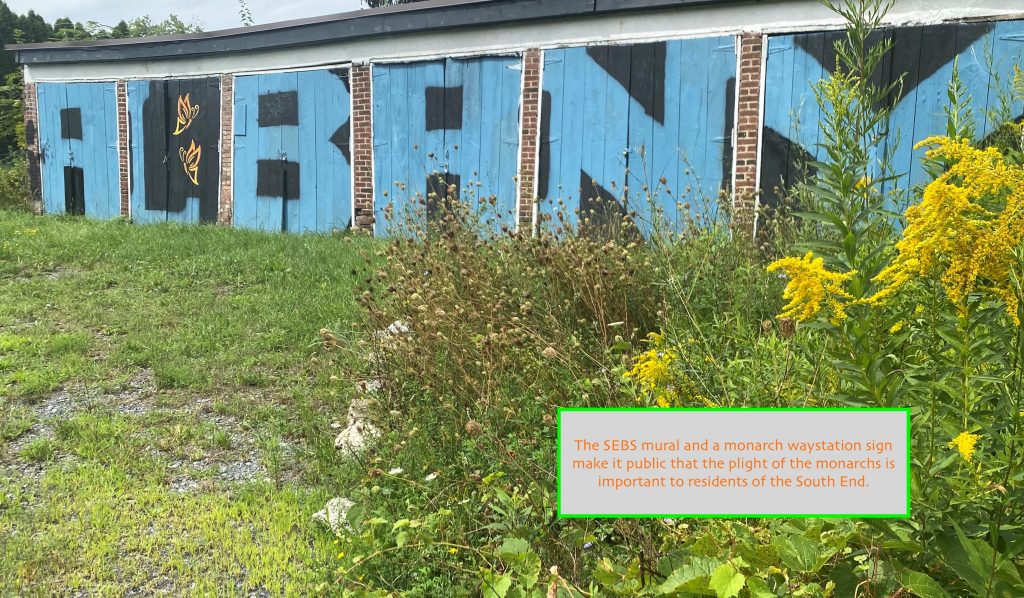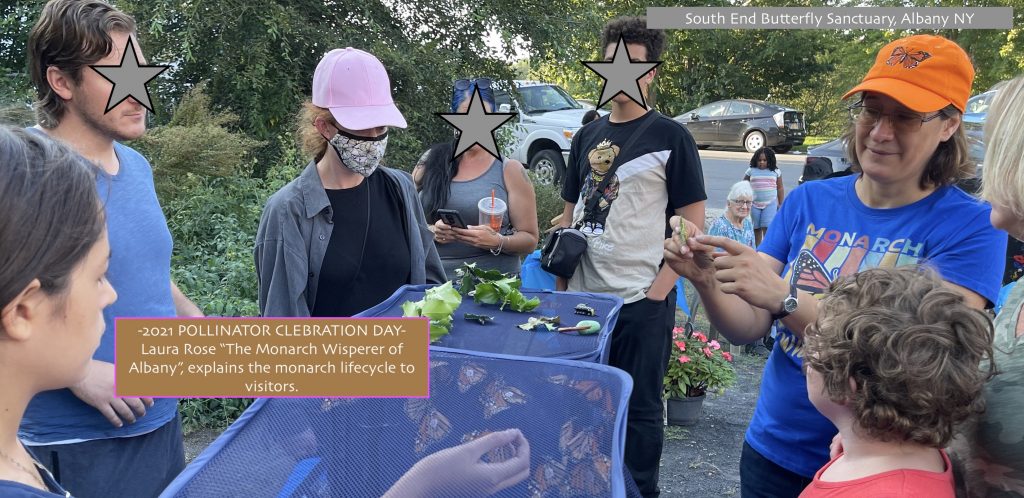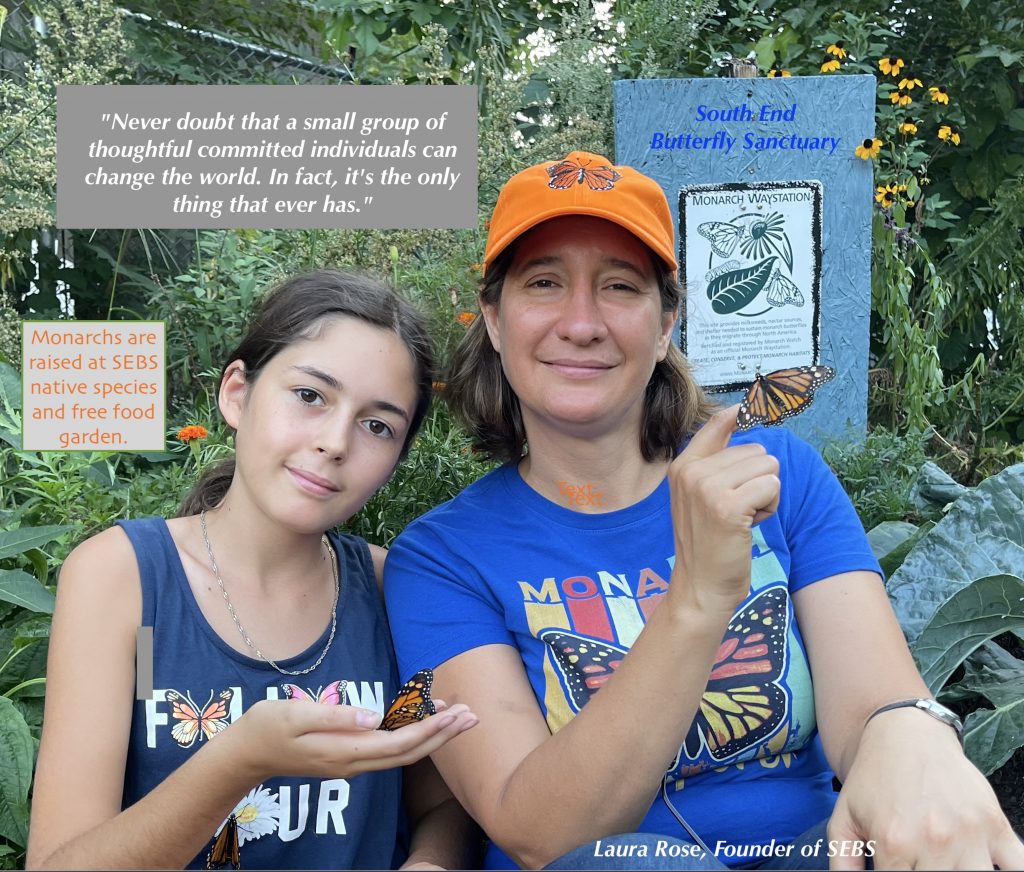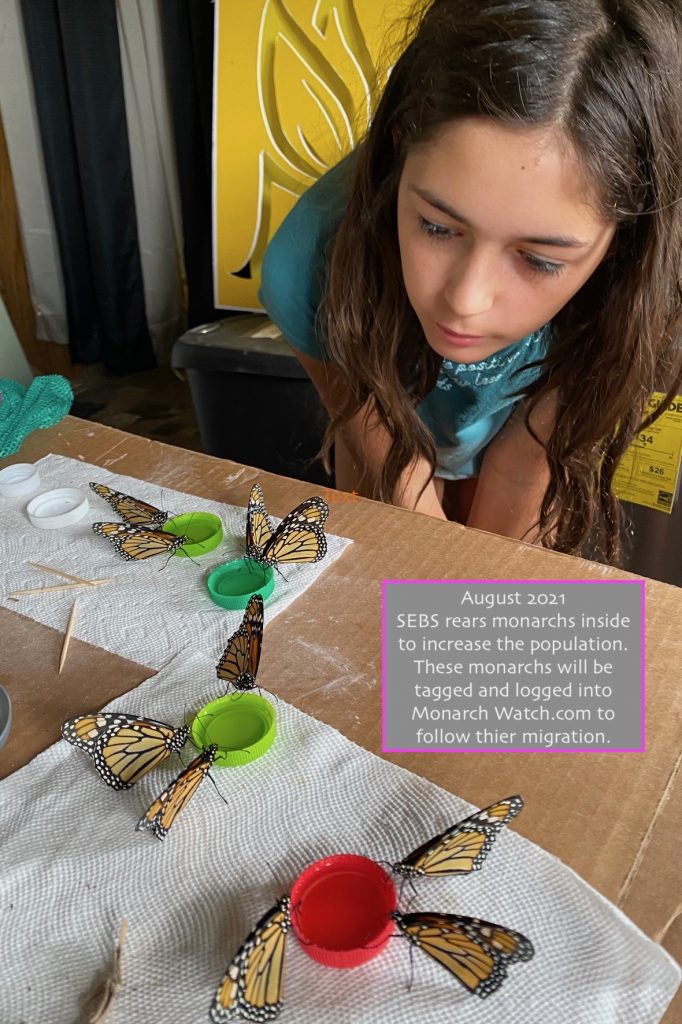By Laura Ferran, Founder of (SEBS) South End Butterfly Sanctuary, Albany NY
ALBANY, NY: My mother Nadia Ferran, now age 89, remembers seeing hundreds of monarchs in the 1970’s in our family yard located in the South End of Albany. But when my young children and I came to live in Albany last year, we saw just ONE. This sighting was both exciting and frightening at the same time. We researched that monarchs are plummeting toward extinction. Numbering some 1.2 million in the 1990s, it declined to fewer than 2,000 butterflies in the 2020 count for the western monarch population. The reasons include some natural events but mostly urban housing, paved roads, and pesticide use has removed the fields of milkweed plants, the only food a monarch caterpillar can eat. No milkweed means no monarch butterfly.
Monarchs, a large orange-and-black butterfly, are only 1 of 2 species of insects that migrate as far as Canada upto 3000 miles back to their winter home in Mexico. When you look at a monarch one could hardly imagine a creature so small and fragile can make such an epic journey. The loss of this beautiful animal is telling of what is happening to other pollinators, as humans remove and/or violate their shared habitat. In addition, the food security of humans is dependent on the ecological services that pollinators provide. No pollinators means no fresh produce for us.

From Nothing To Everything
Understanding that we are either part of the problem or part of the solution, increasing the monarch population at this site became our family’s mission. But the problem was:
- We knew practically nothing about the monarch’s life cycle and needs.
- There was no dirt.
- There were no plants.
- We had no personal fund for this community beautification project.
But what we did have was a tiny wild field area, a large grey gravel parking lot, and in most abundance, a belief that, if we build it, they will come.
So in June of this year we put our intentions out into the universe and the following happened:
- The dirt was donated by the Albany Department of General Services.
- The milkweeds came from a grant program online.
- The butterfly tags and education came from Monarch Watch, the organization responsible for monitoring migration patterns.
- The water bill was relieved by the Albany Water Department.
- The volunteers and plants came from the community.
By August a small miracle happened.

THE PEOPLE ARRIVED.
SEBS held it’s very first event: Pollinator Celebration Day of Albany. We had a half dozen non-profits present their eco-programs, over 50 residents visited, a storyteller and crafts edu-tained the children, live monarchs were on display to be released into the garden, and a few government agents came to applaud the event.
- SEBS won a national Harmony Hero Award hosted by Earthkind.com.
- SEBS to date has 1.3K youtube views!
- SEBS was invited to teach a local school program about monarchs.
- SEBS mural, sign, and facebook page became known by the community.
Then an even smaller miracle happened. THE BUTTERFLIES ARRIVED.
24 WILD monarch larvae were born on SEBS milkweeds and survived to adulthood with the help of my daughters. 25 additional monarch larvae were purchased to build the population. Olivia, age 13, reared all the caterpillars in our kitchen and when they emerged from their chrysalis, she hand fed each butterfly twice a day until the weather was safe for their release. Monarchs extend their proboscis, a straw like tongue, to dip into flowers but they do not naturally understand that a dish of honey water can be food. We had to help them learn to eat and get strong for their release. With the whole process of rearing monarchs, our family gained an education, a relationship with a wild animal, and a community project to help others gain a greater respect for the balance of natural ecosystems.

A SANCTUARY FOR ALL
In addition to monarchs, other animals found refuge at SEBS. During the summer we viewed bunnies, pheasants, opossums, tree frogs, cicadas, groundhogs, several species of birds, praying mantis, bees and other pollinators. The pheasants hung around for over four months, 3 to 8 at a time. A mother opossum gave birth to a litter of 13 joeys which we were honored to watch for several weeks. The pleasure of getting to observe these animals and to know that we have provided them a waystation gave us joy and hope for our urban community.

PLANNING FOR THE FUTURE
SEBS desires to include in the future a self guided tour display, pollinator info totems,two operating bee hives, a community bulletin board, seating area, litter clean up program, adopt a drain program to teach about Albany’s water systems, and inclusion in the CDTA Free Nature Bus stop schedule for local families to gain transport to ecology sites outside of city limits. This is in addition to building onsite a larger milkweed habitat, free vegetable program, and native plant species garden. SEBS also has an outdoor classroom area where as Covid-19 restrictions are reduced, eco-educational programs will be expanded as well as off-site educational programs about the plight of monarchs.
The second annual Pollinator Day Celebration is planned for the second week of August 2022. This event must be carefully timed with the birth of the fourth generation of monarchs, who are the ones who will make the great journey to the monarch’s winter home in Mexico’s Central Highlands. SEBS will know at the end of the year if they are chosen as the winner of a guided trip to Mexico to see the Kingdom of the Monarchs. The contest is hosted by Earthkind.com, who creates pest control products that promote sustainability and preserve the ecosystem through the use of botanical ingredients. This trip would allow SEBS to share the full journey of monarchs, and give a real dimension to the tagging of butterflies so that we as a community care to follow our ALBANY MONARCHS and learn along the way. SEBS is located in a highly visible and high pedestrian trafficked area and will have active interaction throughout each season. (Watch video at www.youtube.com/watch?v=pJB2MkCwgDE)
As they say, “Never doubt that a small group of thoughtful committed individuals can change the world. In fact, it’s the only thing that ever has.” In only three months our reach has touched about 160 locals in person, another 160 locals online, and 1.3k across America. We serve to be an inspiration that it is ok to take steps even with no previous knowledge. To help the monarchs, it can start with one step- plant a milkweed. For if you build it, they will come.
Laura Rose is a resident of the South End of Albany and founder of SEBS, South End Butterfly Sanctuary. For more info and to get involved with the SEBS, go to Facebook SEBSofAlbanyNY.